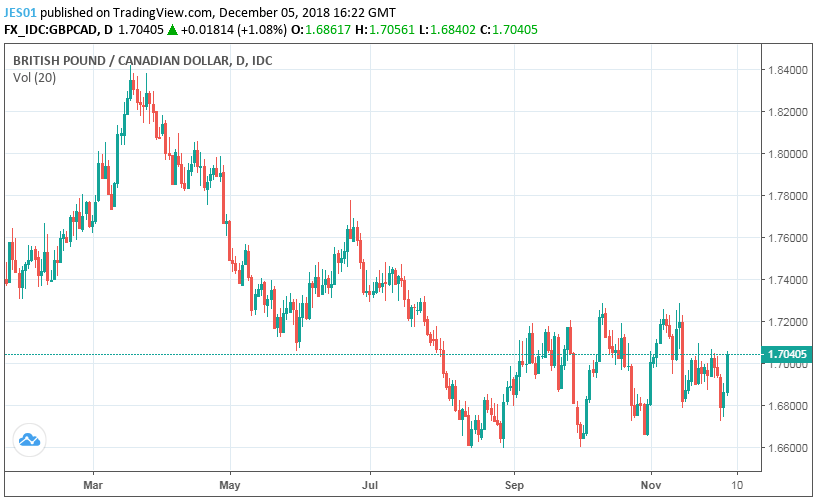The Canadian Dollar: Hammered after Bank of Canada Backs Away from Guidance about Faster Interest Rate Rises
- Written by: James Skinner
-

Image © Bank of Canada
- CAD hits the ropes after BoC backs away from Oct guidance.
- Says oil and other developments have put a dent in its outlook.
- Leading markets to pare rate expectations and dump the Loonie.
The Canadian Dollar weakened rapidly Wednesday after the Bank of Canada (BoC) appeared to back away from earlier guidance that it would step up the pace at which it raises interest rates in 2019.
Bank of Canada officials held the cash rate at 1.75% for December on Wednesday, as was expected by the market, but they flagged a series of recent developments that could easily deter them from raising rates in the future.
"This is a dovish message, but remember that the market has been pricing away rate hikes in the front end rally we've seen in recent weeks. A January hike now depends on seeing much better economic data for October and an OPEC production cut that firms up oil prices," says Avery Shenfeld, chief economist at CIBC Capital Markets.
The BoC says activity in Canada's energy sector is likely to be "materially weaker" than was expected in October when the bank issued guidance suggesting it could lift the cash rate as high as 3.5% by the end of 2020.
It also flagged a poor performance from the economy at the end of the third-quarter as grounds for thinking growth could well come in lower over the coming year than it had previously anticipated. GDP growth stalled in September.
Moreover, it says downward revisions to historic GDP data and the signing of the USMCA agreement, which replaces the North American Free Trade Agreement (NAFTA), mean there could be room for more "noninflationary growth" over coming quarters than was previously thought.
In plain English, all of that means the argument for higher interest rates, certainly the argument for a faster pace of interest rate rises, has weakened of late. As a result, markets are now reappraising their expectations for rates going forward and the Canadian Dollar has responded accordingly.
"The negative spin on the economy makes a January rate hike unlikely. The Bank remains committed to moving rates back to the neutral range, but it looks like the normalization process will be more gradual than anticipated. March remains very much live," says Mark McCormick, North American head of FX strategy at TD Securities.

Above: USD/CAD rate shown at daily intervals.
The USD/CAD rate was quoted 1% higher at 1.3389 following the announcement, after extending an earlier 0.18% gain.
The Pound-to-Canadian-Dollar rate was 1.02% higher at 1.7034 after almost doubling an earlier 0.62% gain.
Both exchange rate moves denote a stronger U.S. Dollar and Pound Sterling as well as a significantly weaker Loonie.
"The policy statement contained little positive news for the loonie. The next level to watch for USDCAD is 1.34, where we see [fair value], although we prefer to play CAD weakness on the crosses with NOK and GBP the most attractive candidates," TD's McCormick adds.

Above: Pound-to-Australian-Dollar rate shown at daily intervals.
The Bank of Canada raised its interest rate by 25 basis points to 1.75% in October and said it will go on lifting its benchmark over coming quarters, potentially taking it up to 3.5% some time in 2020.
However, since then some economic statistics have left a sour taste in the mouths of analysts and the market for oil, which is Canada's largest export, has gone from boom to bust in spectacular fashion.
Although decisions to raise rates are normally only made in response to signs of that inflation will rise further down the track, the recent economic and oil price price developments in Canada all point to lower inflation.
"While the Bank sees rates moving into the neutral "range", the addition of that word "range" from the prior statement, and the new qualifying words added to what the Bank will be watching for the timing of those hikes (including the oil price shock and business investment, as well as a reestimate of the non-inflationary capacity), are in line with our view that rates could peak at only 2.25% next year," says CIBC's Shenfeld.
Canada's oil market has recently fallen into even more dire straits than the global one, with prices setting new record lows repeatedly in the fourth-quarter, leading the Alberta regional government to issue a statement Monday requiring oil producers to cut their production next year.
The government says it hopes production cuts will boost prices by reducing oversupply in the market but the move led economists to immediately cut forecasts for economic growth this quarter and next, given the anticipated impact on business investment and jobs in the province.
"The Bank seems to share our concerns – oil prices featured heavily in the discussion, with the Bank noting that activity will be materially weaker in the energy sector and going so far as to include a reference to oil in the forward looking language. The pessimistic tone didn't stop with the energy sector though," McCormick adds.
Pricing in interest rate derivative markets, which provide insight into investor expectations for monetary policy, has shown a clear deterioration in the interest rate outlook since the end of October. If economic data released in December and January continue to encourage that trend then the Canadian Dollar could suffer as a result.
Advertisement
Bank-beating exchange rates. Get up to 5% more foreign exchange by using a specialist provider to get closer to the real market rate and avoid the gaping spreads charged by your bank when providing currency. Learn more here










